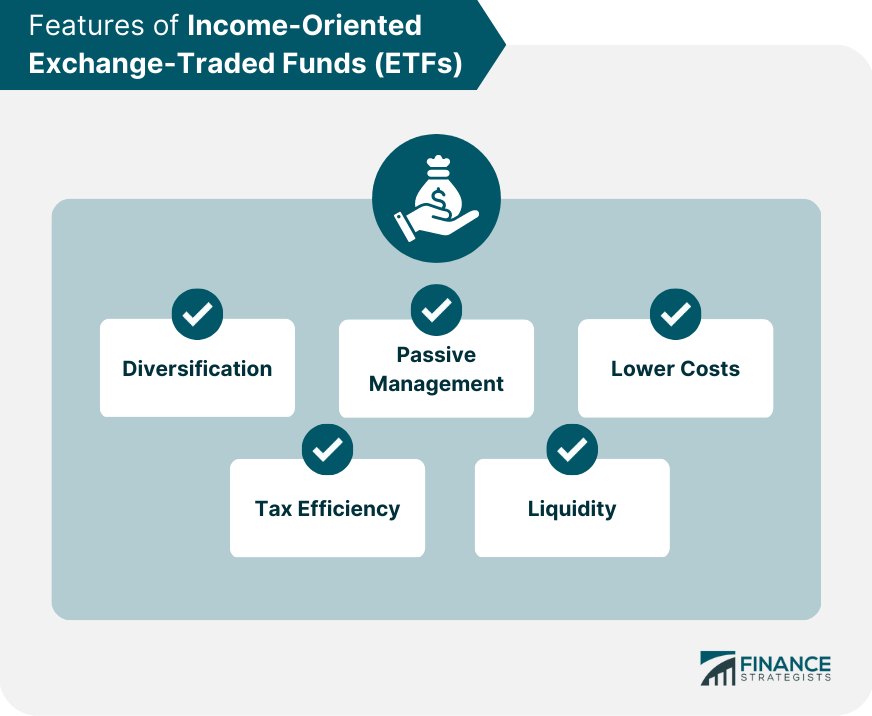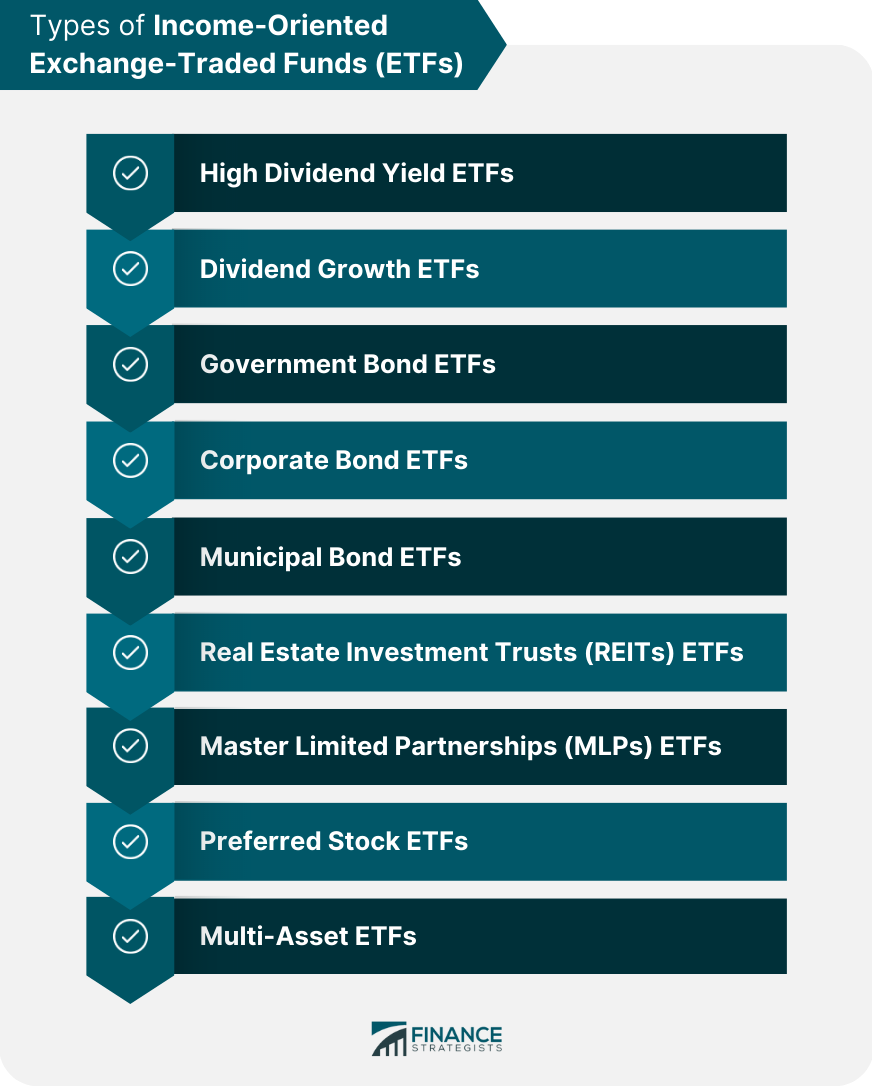Income-Oriented Exchange-Traded Funds (ETFs) are investment funds that focus on generating income for investors by investing in assets that generate income, such as bonds, preferred stocks, and dividend-paying stocks. ETFs provide investors with an attractive way to generate income through diversified portfolios. Income-Oriented ETFs allow investors to diversify their income streams by investing in a broad range of income-generating assets. This reduces the risk associated with concentrating investments in a single asset class or sector. Most income-oriented ETFs are passively managed, meaning they track an underlying index designed to represent a specific income strategy. This passive approach results in lower management fees compared to actively managed funds. ETFs generally have lower expense ratios compared to mutual funds due to their passive management approach and lower operating costs. This can lead to higher net returns for investors. Income-Oriented ETFs can be more tax-efficient than mutual funds, as they generate fewer capital gains distributions due to their unique structure. ETFs trade on stock exchanges, allowing investors to buy and sell shares throughout the trading day. This liquidity can be advantageous for investors who need to access their investments quickly. These ETFs invest in stocks with high dividend yields, offering investors a steady stream of income. Dividend growth ETFs focus on companies with a history of consistent dividend increases, potentially providing investors with growing income streams. These ETFs invest in government-issued bonds, providing investors with relatively low-risk income streams. Corporate bond ETFs invest in bonds issued by corporations, offering potentially higher yields than government bonds but with increased credit risk. Municipal bond ETFs invest in bonds issued by state and local governments, providing tax-exempt income for qualifying investors. REITs ETFs invest in a diversified portfolio of real estate investment trusts, which own and manage income-producing properties. MLPs ETFs invest in master limited partnerships, which are typically involved in transporting, storing, and processing natural resources. These ETFs invest in preferred stocks, which offer a fixed dividend rate and priority over common stock dividends. Multi-asset ETFs invest in a mix of income-producing assets, such as dividend-paying stocks, bonds, and alternative investments. Investors should align their income-oriented ETF choices with their investment goals, time horizon, and risk tolerance. Evaluating the expense ratios and other fees associated with income-oriented ETFs is crucial, as higher costs can reduce net returns. Larger and more liquid ETFs tend to have lower bid-ask spreads and more efficient pricing, making them more cost-effective for investors. Investors should consider the ETF's yield and how often it distributes income, as this can impact cash flow and overall returns. Understanding the underlying index and its methodology can help investors select an ETF that best aligns with their income strategy. When investing in fixed-income ETFs, evaluating the credit quality and duration of the underlying bonds is essential, as these factors affect risk and potential returns. Investors should consider the sector and geographic diversification of income-oriented ETFs to ensure proper risk management and exposure to various income sources. Income-Oriented ETFs are designed to generate consistent income streams, making them attractive for investors seeking regular cash flow. These ETFs provide exposure to a broad range of income-generating assets, reducing portfolio risk through diversification. Income-Oriented ETFs typically exhibit lower volatility than growth-focused investments, providing a more stable investment option. Some income-oriented ETFs, such as those investing in inflation-protected bonds or real assets, can offer a degree of inflation protection. Income-focused investments tend to prioritize capital preservation over capital appreciation, making them more suitable for conservative investors. Changes in interest rates can negatively affect the prices of income-oriented ETFs, particularly those with longer durations or fixed-income holdings. Corporate or municipal bonds expose investors to credit risk, as the issuers may default on their obligations. Inflation can erode the purchasing power of income generated by ETFs, reducing the real return for investors. Some income-oriented ETFs may invest in less liquid assets, making it challenging to buy or sell shares at desired prices during periods of market stress. International income-oriented ETFs may expose investors to currency risk, as fluctuations in exchange rates can impact returns. Like all investments, income-oriented ETFs are subject to market risk, which can lead to losses in the event of a market downturn. Investors should consider the tax implications of their income-oriented ETF investments, as different asset classes and structures may have varying tax consequences. Income-Oriented ETFs can play a crucial role in constructing a balanced portfolio by providing steady income and diversification benefits. Investors can combine growth-oriented and income-oriented ETFs to create a portfolio that balances capital appreciation and income generation potential. Allocating a portion of a portfolio to income-oriented ETFs can help investors manage risk and achieve long-term investment objectives. Regularly rebalancing the portfolio ensures that the desired allocation remains intact. Investors should consider tax-efficient income-oriented ETFs, such as those investing in municipal bonds or certain international assets, to minimize the tax impact on their returns. A selection of popular income-oriented ETFs includes: Vanguard High Dividend Yield ETF (VYM): This ETF tracks the performance of the FTSE High Dividend Yield Index, focusing on U.S. large-cap stocks with high dividend yields. iShares Select Dividend ETF (DVY): DVY aims to replicate the performance of the Dow Jones U.S. Select Dividend Index, investing in U.S. dividend-paying stocks with a positive track record. Schwab U.S. Dividend Equity ETF (SCHD): SCHD tracks the performance of the Dow Jones U.S. Dividend 100 Index, focusing on high dividend-paying U.S. stocks with strong fundamentals. iShares iBoxx $ Investment Grade Corporate Bond ETF (LQD): LQD seeks to track the performance of the Markit iBoxx USD Liquid Investment Grade Index, investing in U.S. investment-grade corporate bonds. Vanguard Total Bond Market ETF (BND): BND aims to replicate the performance of the Bloomberg U.S. Aggregate Bond Index, providing broad exposure to the U.S. investment-grade bond market. iShares U.S. Real Estate ETF (IYR): IYR tracks the performance of the Dow Jones U.S. Real Estate Index, investing in U.S. real estate investment trusts (REITs) and real estate stocks. Global X MLP ETF (MLPA): MLPA seeks to replicate the performance of the Solactive MLP Infrastructure Index, investing in master limited partnerships (MLPs) involved in the transportation, storage, and processing of natural resources. iShares U.S. Preferred Stock ETF (PFF): PFF aims to track the performance of the ICE Exchange-Listed Preferred & Hybrid Securities Index, providing exposure to U.S. preferred stocks. SPDR DoubleLine Total Return Tactical ETF (TOTL): TOTL is an actively managed ETF that invests in various fixed-income assets, including government, corporate, and mortgage-backed securities. Invesco Multi-Asset Income ETF (IYLD): IYLD is a multi-asset ETF that seeks to track the performance of the Morningstar Multi-Asset High Income Index, investing in a diversified mix of income-producing assets. When evaluating the top income-oriented ETFs, investors should consider factors such as historical returns, yield, distribution frequency, risk-adjusted performance, and expense ratios. Comparing these metrics across various ETFs can help investors select the most suitable income-oriented ETFs for their investment portfolios. Income-Oriented ETFs can be an attractive investment option for investors seeking to generate income from their portfolio. These ETFs invest in a diversified portfolio of income-generating assets, such as bonds, preferred stocks, and dividend-paying stocks, which can provide stable and regular income for investors. However, investors must also understand the risks associated with income-oriented ETFs, such as interest rate and credit risk. By conducting proper research and due diligence, investors can select income-oriented ETFs that align with their investment objectives and risk tolerance. Furthermore, combining growth and income strategies within a balanced portfolio can help investors achieve their long-term financial goals. Investors should consider their overall investment objectives, risk tolerance, and time horizon when selecting income-oriented ETFs as part of their investment strategy.What Are Income-Oriented ETFs?
Features of Income-Oriented ETFs
Diversification
Passive Management
Lower Costs
Tax Efficiency
Liquidity

Types of Income-Oriented ETFs
Dividend-focused ETFs
High Dividend Yield ETFs
Dividend Growth ETFs
Fixed Income ETFs
Government Bond ETFs
Corporate Bond ETFs
Municipal Bond ETFs
Real Estate Investment Trusts (REITs) ETFs
Master Limited Partnerships (MLPs) ETFs
Preferred Stock ETFs
Multi-Asset ETFs

Factors to Consider When Selecting Income-Oriented ETFs
Investment Objectives and Risk Tolerance
Expenses and Fees
Fund Size and Liquidity
Yield and Distribution Frequency
Underlying Index and Methodology
Credit Quality and Duration (For Fixed Income ETFs)
Sector and Geographic Diversification
Benefits of Investing in Income-Oriented ETFs
Steady Income Generation
Diversification Benefits
Lower Volatility Compared to Growth-Oriented Investments
Inflation Protection (For Certain Types of ETFs)
Capital Preservation
Risks and Challenges Associated With Income-Oriented ETFs
Interest Rate Risk
Credit Risk
Inflation Risk
Liquidity Risk
Currency Risk (For International ETFs)
Market Risk
Tax Implications
Income-Oriented ETFs and Portfolio Construction
Incorporating Income-Oriented ETFs in a Balanced Portfolio
Blending Growth and Income Strategies
Asset Allocation and Rebalancing
Tax-Efficient Strategies
Top Income-Oriented ETFs to Consider
List of Well-known Income-Oriented ETFs
Performance Metrics and Comparisons
Conclusion
Income-Oriented ETFs FAQs
Income-Oriented ETFs are exchange-traded funds that primarily invest in assets that generate income, such as bonds, preferred stocks, and dividend-paying stocks, with the goal of providing regular income to investors.
Income-Oriented ETFs focus on generating income for investors, while other ETFs may aim to track the performance of a particular index or asset class. Income-Oriented ETFs typically hold assets with lower volatility and lower growth potential, while other ETFs may hold more volatile and growth-oriented assets.
Income-Oriented ETFs may be suitable for investors who prioritize generating income from their investments, such as retirees or those nearing retirement. They may also appeal to investors seeking more stable returns and lower risk than growth-oriented investments.
Income-Oriented ETFs are not without risk. They may be vulnerable to changes in interest rates, credit risk, and issuer default risk, among other factors. Additionally, income-oriented ETFs may need to catch up with inflation, leading to a decline in purchasing power over time.
While Income-Oriented ETFs are primarily designed to generate income, they may also provide some long-term growth potential through reinvested dividends and potential capital appreciation. However, investors seeking significant long-term growth may want to consider other types of investments, such as growth-oriented ETFs.
True Tamplin is a published author, public speaker, CEO of UpDigital, and founder of Finance Strategists.
True is a Certified Educator in Personal Finance (CEPF®), author of The Handy Financial Ratios Guide, a member of the Society for Advancing Business Editing and Writing, contributes to his financial education site, Finance Strategists, and has spoken to various financial communities such as the CFA Institute, as well as university students like his Alma mater, Biola University, where he received a bachelor of science in business and data analytics.
To learn more about True, visit his personal website or view his author profiles on Amazon, Nasdaq and Forbes.











